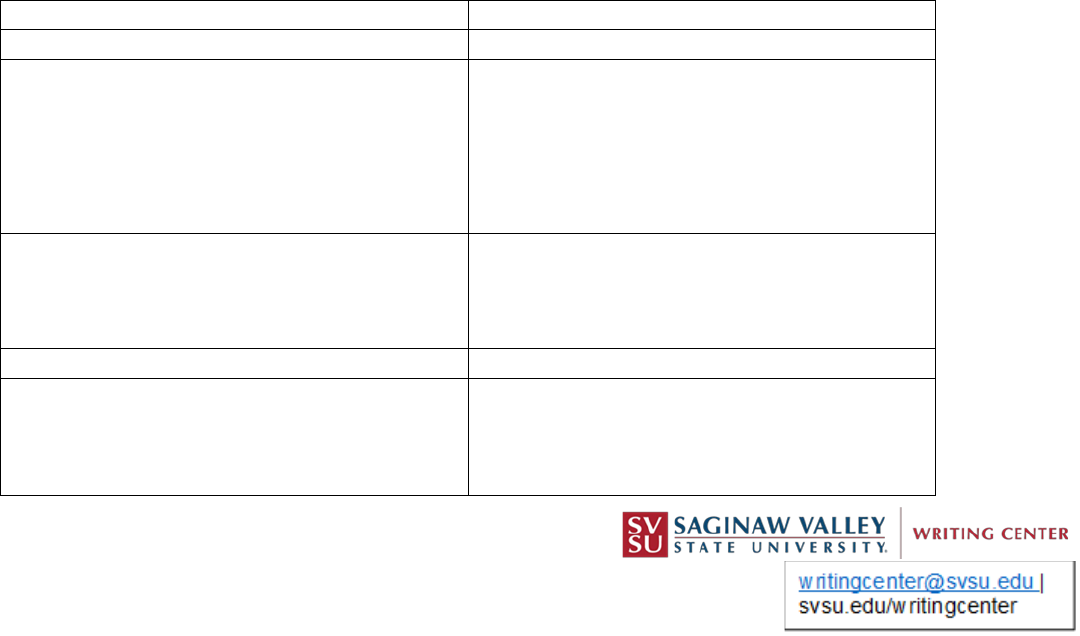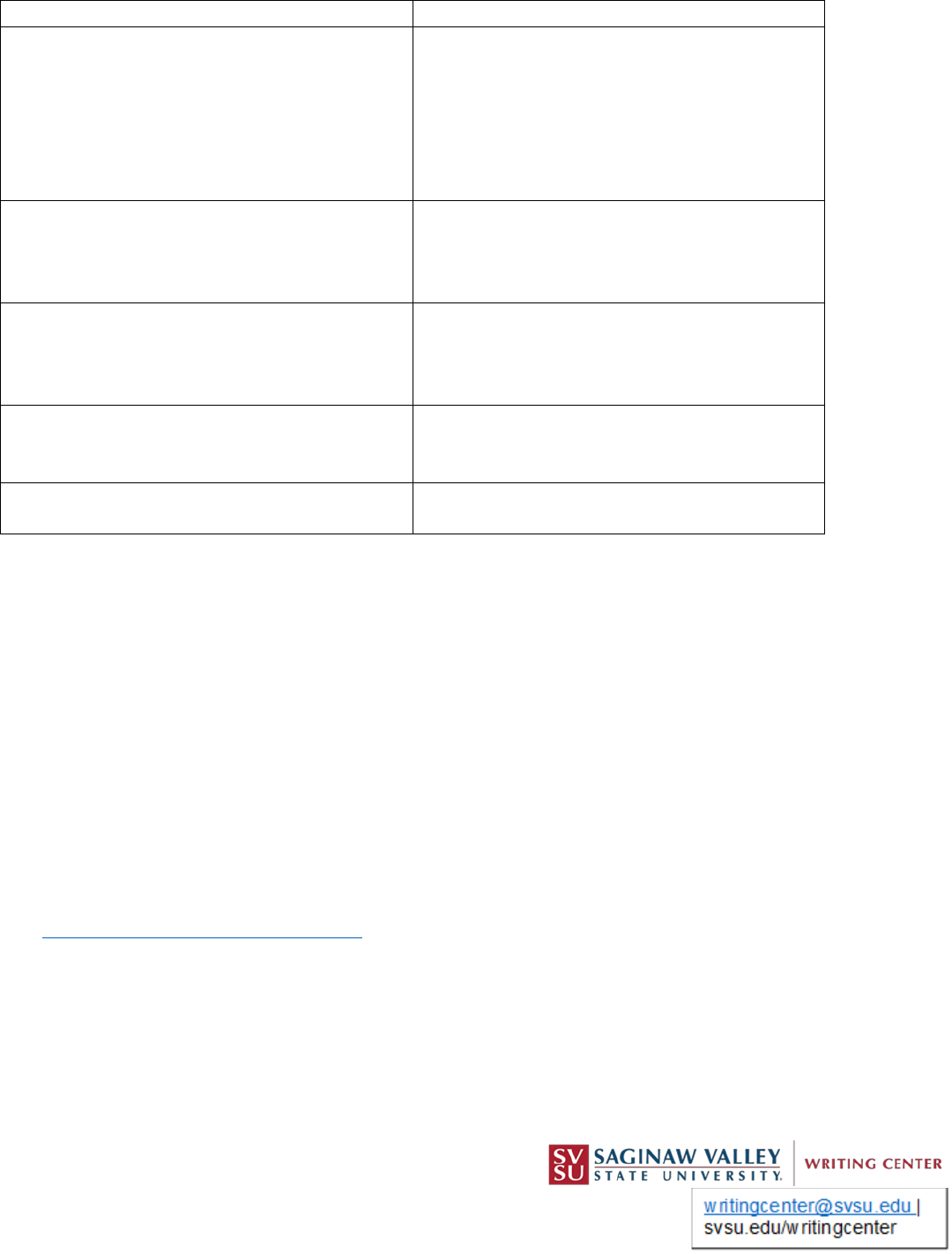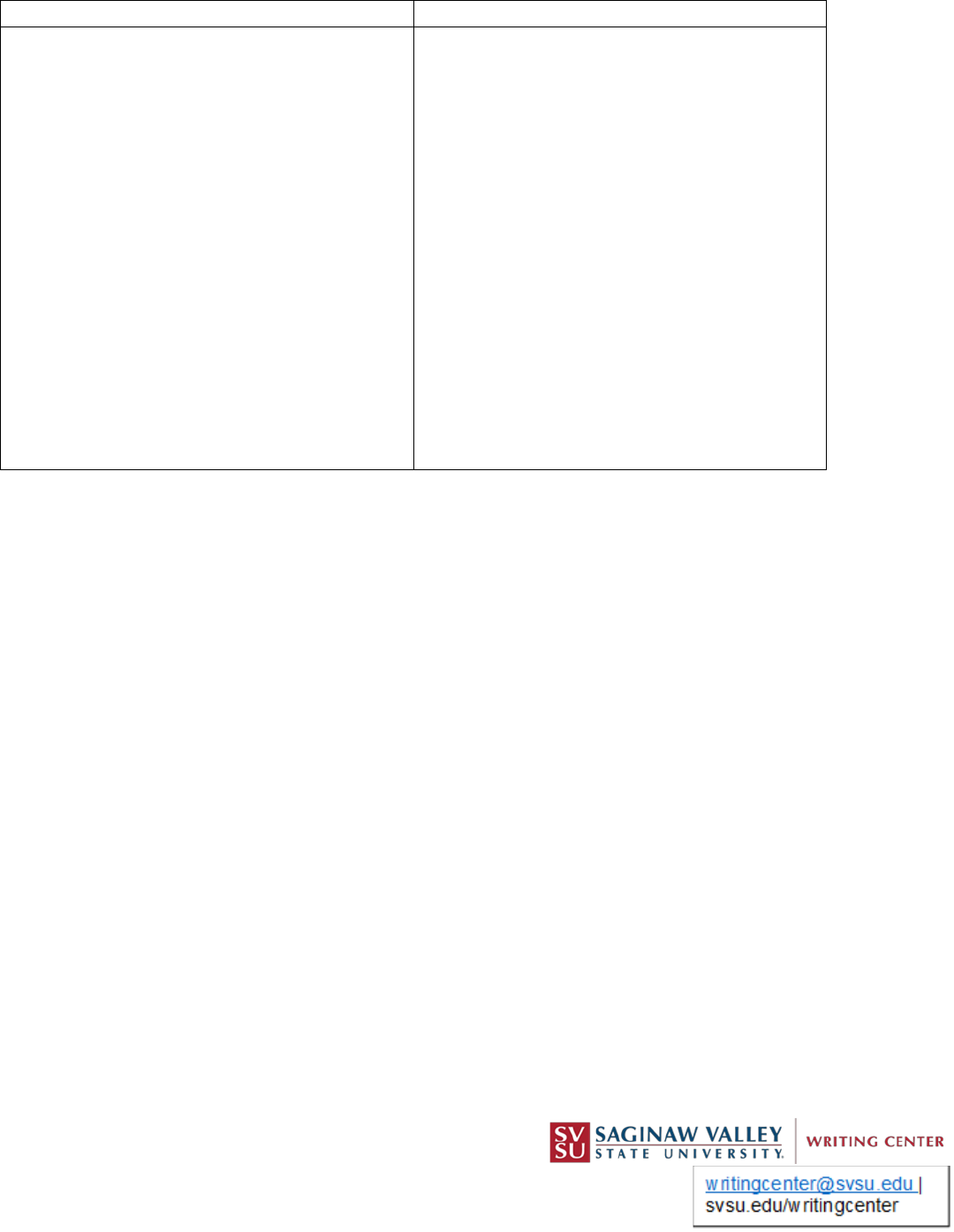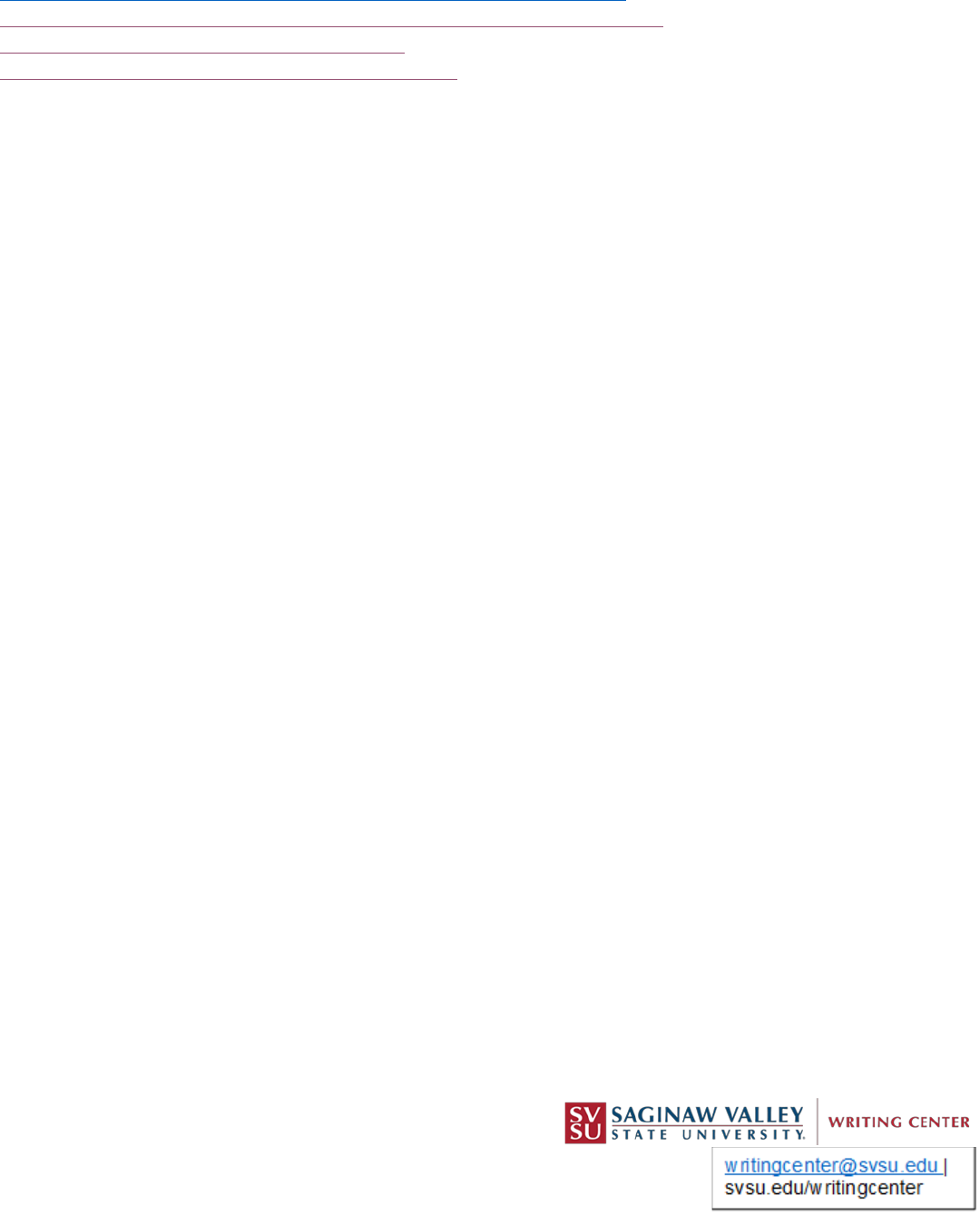
Revised 4/2022
AMA/APA Style Comparison
Format Basics
APA
AMA
Used in the Social Sciences; may also be used
in other disciplines (e.g., Nursing, Education);
Publication
Manual written for students and professionals
Used in health care, medicine, and nursing to
present their ideas with a clear structure for
their reading audiences
Authoritativeness based on how current the
information is, where it was published, and
credentials
of the author, as well as the quality of the
information
AMA 11 style emphasizes the need to cross
reference source material, within the paper
Uses graphics (e.g., tables, charts) frequently
to
present data and prescribes graphics format
(Publication Manual, Ch. 7); places graphics
after
References OR in text
In AMA style papers, tables and figures are
included in the body of the report. Section 4.0
of the AMA Manual of Style outlines how to
format tables, figures, and multimedia. Tables
and figures are numbered consecutively:
Figure 1, Figure 2, etc.
Recommends headings and prescribes format
for up to
five levels of headings (pp. 47–49)
The AMA Manual outlines four different
heading levels. The title of your report and
Level 1 headings must be in bold Arial 14-
point font. Level 2 headings are in bold Arial
12-point font. Level 3 headings are in bold
Arial 12-point font and underlined. Level 4
headings are in bold Arial 12-point font and
italicized.
The title page should include page number
(and last name of writer in the running head),
paper title, Author byline, full course name,
instructor info, date (middle of the first page)
The title page should include the report's title
(in both the running head and in the middle of
the first page), student's name, date, and word
count, page number(should start on the
second page)
Provides header on upper right of all pages:
on student
papers only page numbers appear
Provides header on upper right of all pages
(bold), subheadings italics
Abstract is on the second page, after the title
page.
Abstract is on the first page after the title page
information

Revised 4/2022
Examples of formatting Abstracts/Title pages
APA Title page:
1
Cross-Cultural Studies of Depression
Janet F. Wilson and Paul E. Thompson
Department of Nursing, Saginaw Valley State University
NURS 245: Nurse Provider Clinical I
Professor Judi A. Cox
December 8, 2019
APA Abstract (separate page from Title page, it’s after the Title page. The Abstract is on a
separate page from the paragraphs):
2
Abstract
The nursing profession recognizes the phenomenon of anxiety as a nursing diagnosis and has
studied it in depth. Anxiety is defined as a vague subjective feeling of apprehension stemming
from an unknown threat to an individual. Anxiety is divided into four stages: mild, moderate,
severe, and panic. Sister Callista Roy’s theory of adaptation approaches anxiety holistically,
stressing the interconnectedness of the mind, body, and spirit. Martha Rogers’ theory of energy
fields explains anxiety as a phenomenon that is capable of being transmitted between persons.
AMA Title and first page(Title and Abstract are on their own page. Paragraphs are after the
following on a separate page):

Revised 4/2022
Adherence to a mixture of raw food-based diets and their effects on disease and illness.
Andrea D. Comer & Eli A. Cox
Western Oregon University
AMA Abstract (first page after Title):
Abstract
Objective: To further analyze the effects consumption of a plant based diet will have on
conditions of chronic disease and other illnesses. Methods: We used tertiary data extracted from
previous literature analysis pertaining to our topic of interest. Results: While there are proven
benefits to eating a diet focused on raw foods in a short time span, more evidence is needed to
show that a raw food diet alone can consistently have positive effects on disease and illness for
long term adherents.
Key Words: Raw diet, uncooked health benefits, disease prevention, vegan, B12, obesity,
food borne illness, energy deficiency
List of formats
APA
AMA
List of Sources (in bold): References
List of Sources (in bold): References
Includes all sources cited in the text except
personal
interviews, non-retrievable data, and entire
websites
Items are listed numerically in the order they
are cited in the text. Periodicals (journals,
magazines, and newspapers) should have
abbreviated titles. To check for the proper
abbreviations, search the PubMed journal
database
Uses author’s last name, with initials only of
first and middle names
Author last name ,then first and middle
initials (no period). Article title. Journal
Name. Year; volume(issue No.): inclusive
pages. doi: xxxxx
Reverses every co-author’s first and last name
Reverses every co-author’s first and last name
Uses commas between names of multiple
authors (up
to 20); uses an ampersand (&) before the last
author’s
Uses commas between names of multiple
authors (up
to 20); uses an ampersand (&) before the last
author’s

Revised 4/2022
name
name
Omits place of publication (unless place is
important to paper being written)
References should include:
Corresponding superscript number.
Author(s).
Article title.
Abbreviated Journal Title.**
Date; volume(issue): pages.
Online Journal Articles.
Does not use quotation marks around, or
underlining
of, article titles; italicizes book, journal,
report, and webpage titles
Article titles are not italicized, bold or
underlined.
Abbreviated Journal Titles** are italicized
Capitalizes only the first word of the title and
subtitle
of articles and books; capitalizes all proper
names and periodical titles/names
Capitalize the first word of the Article title*,
Capitalize all of the phrases within the
Abbreviated Titles**
Prefers DOI over URL; DOI supplied when
known
even if print version of source was used
Prefers DOI over URL; DOI supplied when
known
even if print version of source was used
Uses date of retrieval only if information is
meant to change
Uses date of retrieval only if information is
meant to change
* Example of a written Article title: PRIDE and prejudice
** Abbreviated Journal Titles: It is discouraged to use acronyms, abbreviations, and initialisms,
except if the resources are well-known. It may include accepted units of measurement and some
well-recognized terms.
If you do use an acronym, abbreviation, or initialism, spell it out with its first use, even if
it is well-known. Do not place periods between the letters of an acronym, abbreviation, or
initialism. Stated names should always appear as full names in the text of a manuscript. If
included in references, use the two-letter abbreviation (first name initial and middle name
initial). Abbreviate and italicize titles of materials based on the National Library of Medicine
database.
Examples of Reference entries
APA journal:
Gulicovski, J., Cerovic, L., Milonjic, S., & Popovic, I. (2008). Adsorption of itaconic acid from
aqueous solutions onto alumina. Journal of the Serbian Chemistry Society, 73(8–9), 825–
834. https://doi.org/10.2298/JSC0809835P (see APA resources for more examples)
AMA journal:
1. Domingo J. Influence of cooking processes on the concentrations of toxic metals and
various organic environmental pollutants in food: a review of the published literature.
Crit Rev Food Sci Nutr. 2011;51(1):29-37.

Revised 4/2022
In-text Citations
APA
AMA
For summaries or paraphrases, uses author’s
last name
and publication date separated by a comma;
e.g.,
(Johnson, 1992).
For quotations, also includes page number,
time
stamp, section heading, paragraph number;
e.g.,
(Johnson, 1992, p. 140)
The author and year information appears
together
whether in an attributive tag or a
parenthetical; e.g.,
Johnson (1992) argued that “….” (p. 140) OR
One
researcher has argued “…..“ (Johnson, 1992,
p. 140).
Each citation number should match the
reference number order. If you use a direct
quote from another work, you should enclose
the quote within quotation marks. If the direct
quote is longer than four lines, the quote
should be set off and indented in a distinct
block, should be presented in reduced type,
and should appear without quotation marks.
The superscript numbers that identify your
use of a borrowed piece of information and/or
idea should appear outside (or to the right) of
commas, periods, and quotation marks, and
should appear inside (or to the left) of colons
and semicolons.***
*** If there are multiple authors used in a source: If you borrow pieces of information come
from more than one source in a single passage or sentence, be sure to identify each of the sources
with a unique superscript number.
Multiple superscript numbers should be separated by commas and should not have spaces
between them.
Pieces of information borrowed from interviews, emails and letters (personal)– it should be cited
with parenthesis’s within the text of your paper. You should include the person’s name, as well
as the type and the date of the communication, in the citation.
Examples of in-text citations
APA:
One study (Svartvik & Leech, 2006) has suggested that…
Svartvik and Leech (2006) have suggested that…
One study has suggested that ……. (Svartvik & Leech, 2006).
(see APA resources for more examples)
AMA:
The association between dietary intake and overall physical health has proven to have a
parallel relationship in conjunction with one another. The human diet plays a very important role
in the etiology and prevention of cancer and other serious cardiovascular and neurodegenerative
diseases.
1

Revised 4/2022
For more information on AMA and sample papers:
https://owl.purdue.edu/owl/research_and_citation/ama_style/index.html
https://www.bellevuecollege.edu/health/writing/format-and-style/ama-style/
https://essaypro.com/blog/ama-citation-format
https://libguides.liberty.edu/ama/amastyleformatting
